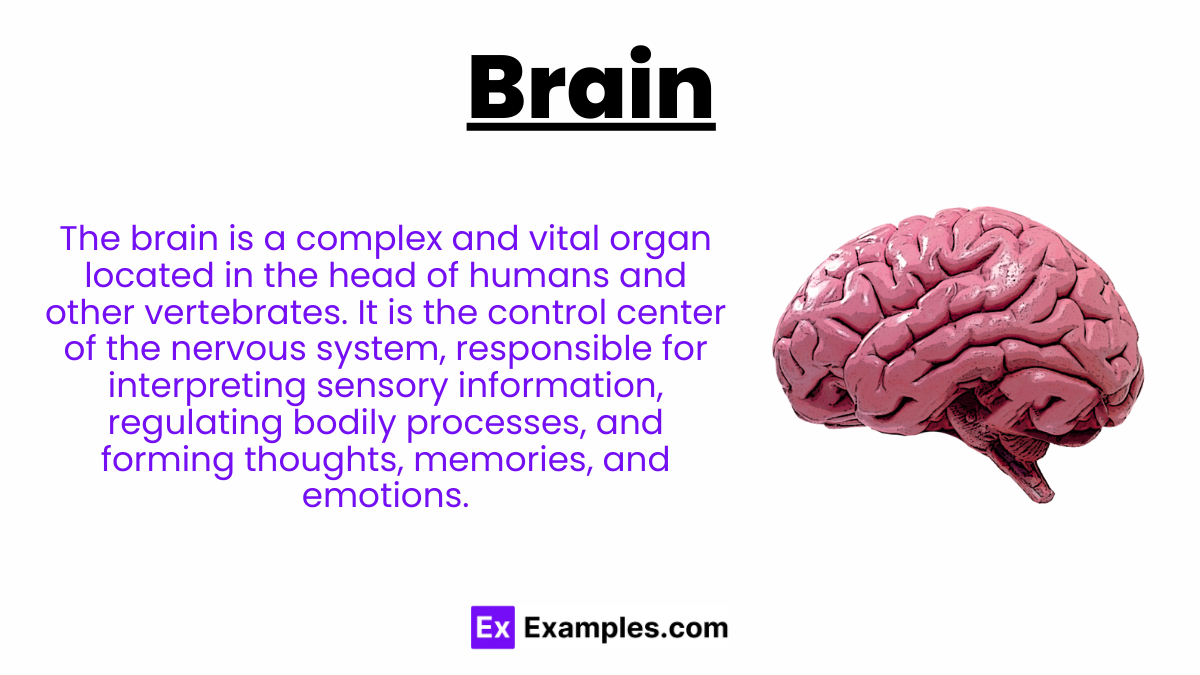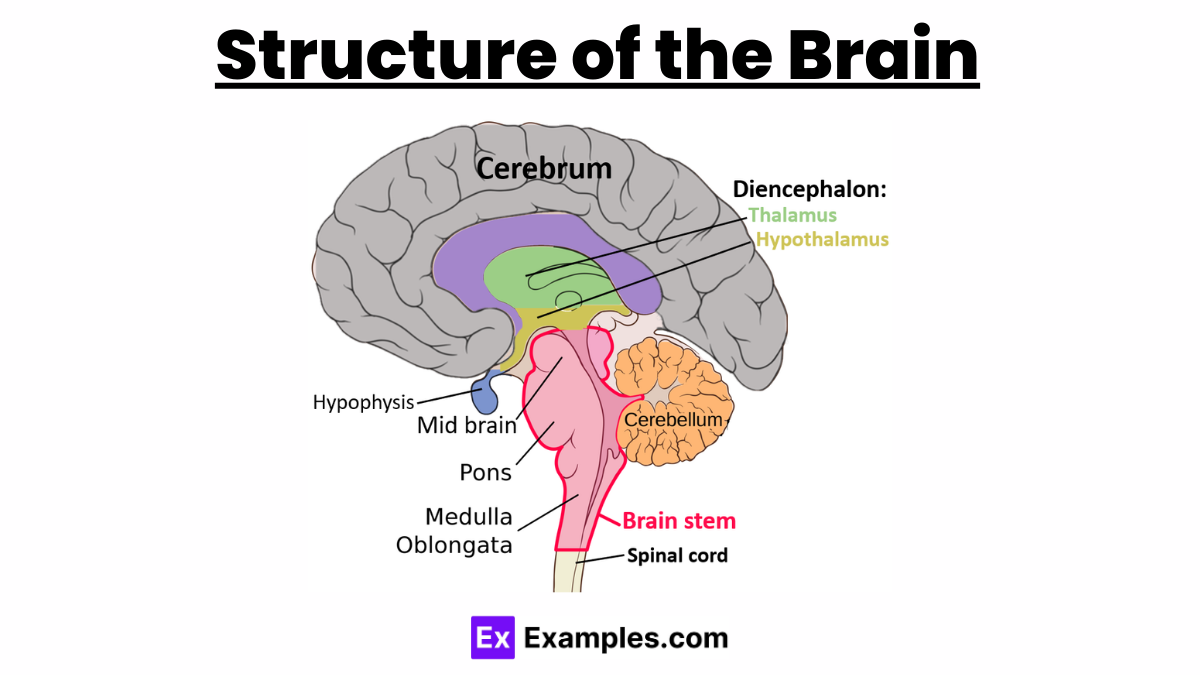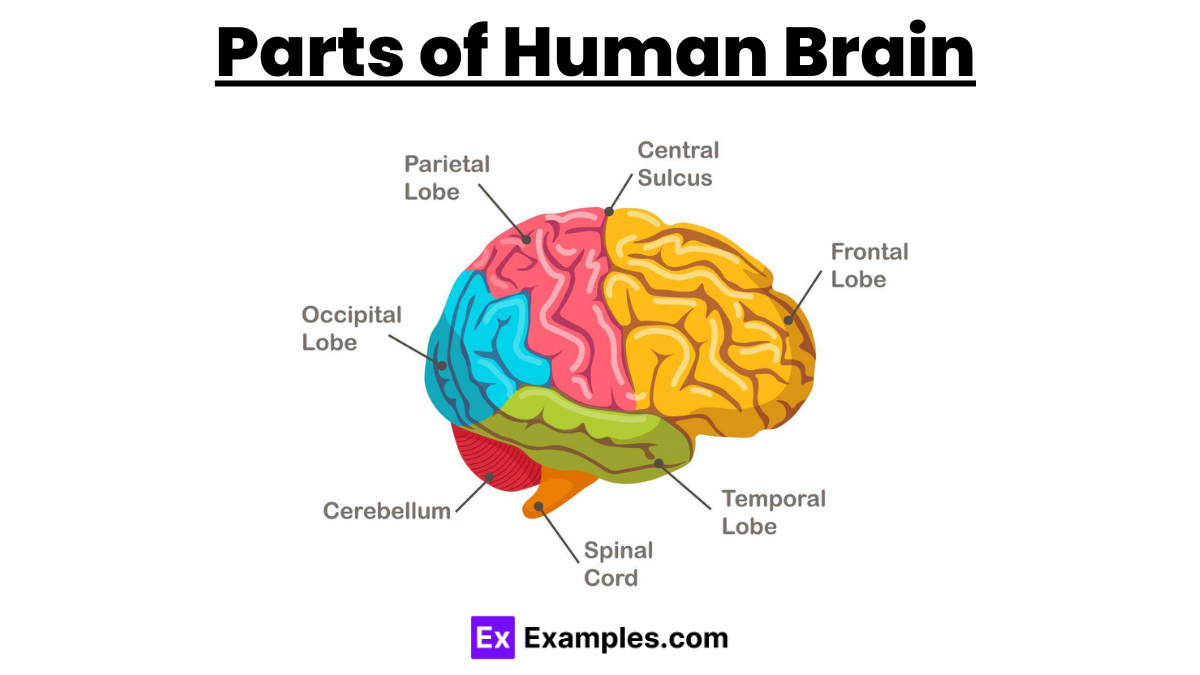Brain – human brain, Structure, Parts, Function
Dive into the depths of human intelligence with our comprehensive guide on the brain. Discover the intricate workings, from neuron-fueled thought processes to memory storage and retrieval. Our expert insights and real-life examples illuminate the complexities of this organ, enhancing your understanding of its vital role in everyday life. Perfect for students, educators, and the curious mind, this resource is your key to unlocking the secrets of the brain’s extraordinary capabilities.
What is Brain?
The brain is a complex and vital organ located in the head of humans and other vertebrates. It is the control center of the nervous system, responsible for interpreting sensory information, regulating bodily processes, and forming thoughts, memories, and emotions. Structurally, it comprises billions of neurons that communicate through synapses, facilitating neural pathways that underpin all aspects of mental functioning. It’s divided into multiple areas, each with specialized functions, such as the cerebrum for cognition and coordination, the cerebellum for motor control, and the brainstem for involuntary activities. As the seat of consciousness, the brain enables the rich tapestry of human experience.
The human brain
The human brain is a complex and sophisticated organ responsible for controlling all functions of the body, interpreting information from the outside world, and embodying the essence of the mind and soul. Intelligence, creativity, emotion, and memory are a few of the many things governed by the brain. Structurally, the brain can be divided into several parts, each with specific functions.
Major Parts of the Human Brain:
- Cerebrum: The largest part of the brain, responsible for higher brain functions such as thought, action, reasoning, and creativity. It’s divided into two hemispheres (left and right) and further into lobes that specialize in different functions.
- Cerebellum: Located under the cerebrum, its functions include coordinating muscle movements and maintaining posture and balance.
- Brainstem: Acts as a relay center connecting the cerebrum and cerebellum to the spinal cord. It plays a crucial role in controlling autonomic functions such as breathing, heart rate, and blood pressure.
Key Functions:
- Cognitive Functions: Including reasoning, problem-solving, and planning, largely managed by the frontal lobes.
- Sensory Processing: Each of the brain’s lobes is associated with specific sensory functions, such as vision in the occipital lobe and hearing in the temporal lobes.
- Memory: Both short-term and long-term memories are processed and stored in different parts of the brain, especially in the hippocampus and temporal lobes.
- Emotional Responses: The limbic system, which includes structures such as the amygdala and hippocampus, is essential in processing and regulating emotions.
Communication and Connectivity:
The brain communicates internally and with the rest of the body through neurons, which transmit signals via neurotransmitters. The brain’s remarkable connectivity is exemplified by the estimated 100 billion neurons it contains, each connected to thousands of others, forming a complex network of communication pathways.
Brain Health and Challenges:
Maintaining brain health is crucial for overall well-being. Factors such as nutrition, exercise, sleep, and mental challenges like learning new skills can positively impact brain health. Conversely, the brain is susceptible to various diseases and conditions, such as Alzheimer’s disease, Parkinson’s disease, and traumatic injuries, which can significantly impair its functioning.
The human brain’s complexity and capability continue to be subjects of extensive research and fascination. Advances in neuroscience are expanding our understanding of the brain, offering new insights into its functioning, potential for healing, and the profound mysteries of consciousness and human nature.
The structure of the human brain is both complex and intricate, facilitating a wide range of functions from basic survival to advanced cognitive processes. It’s composed of various parts, each with specific roles, and is made up of billions of neurons that communicate through an extensive network of connections. Understanding the brain’s structure is key to grasping how it processes information, controls bodily functions, and enables the myriad aspects of human consciousness and behavior.
Structure of the Brain
- Cerebrum: The largest part of the brain, the cerebrum, is divided into the left and right hemispheres. It’s responsible for cognitive functions such as thinking, reasoning, problem-solving, and emotional response. The cerebrum’s surface, known as the cerebral cortex, is highly folded to increase its surface area and is divided into four lobes:
- Frontal Lobe: Involved in decision making, problem solving, planning, and aspects of personality and emotional control.
- Parietal Lobe: Processes sensory information such as touch, temperature, and pain, and is involved in spatial orientation and manipulation.
- Temporal Lobe: Important for processing auditory information and is also involved in memory and emotion.
- Occipital Lobe: Primarily responsible for visual processing.
- Cerebellum: Located beneath the cerebrum, its function is to coordinate voluntary movements such as posture, balance, coordination, and speech, resulting in smooth and balanced muscular activity.
- Brainstem: The brainstem is located beneath the cerebrum and in front of the cerebellum, connecting the brain to the spinal cord. It’s composed of the midbrain, pons, and medulla oblongata, and it controls many vital life functions such as breathing, heart rate, and blood pressure.
Additional Key Structures:
- Limbic System: A complex system of nerves and networks in the brain, involving several areas near the edge of the cortex concerned with instinct and mood. It controls basic emotions (fear, pleasure, anger) and drives (hunger, sex, dominance, care of offspring).
- Hippocampus: Essential for memory formation.
- Amygdala: Involved in emotion regulation, especially fear and pleasure responses.
- Thalamus: Acts as the brain’s relay station, channeling sensory and motor signals to the cerebral cortex and regulating consciousness, sleep, and alertness.
- Hypothalamus: Located below the thalamus, it plays a crucial role in the autonomic nervous system and the endocrine system, regulating body temperature, hunger, thirst, sleep, and emotional activity.
Connectivity and C
ommunication:
- Neurons: The brain’s basic structural units, neurons, communicate through electrical and chemical signals across synapses. This vast network of neurons allows for the complex processes of thought, emotion, and coordination.
- White and Gray Matter: The brain contains both white and gray matter. Gray matter consists primarily of neuronal cell bodies and is found in the cortex and certain deep brain structures. White matter consists of axons, which are the long extensions of neurons that carry electrical signals, and is rich in myelin, a substance that speeds up signal transmission.
Parts of Human Brain
The human brain is a complex and sophisticated organ responsible for controlling various bodily functions, as well as the center for intelligence, emotions, thoughts, memory, and language. It’s divided into several main parts, each with specific functions:
- Cerebrum: The largest part of the brain, divided into left and right hemispheres. It controls voluntary movements, sensory processing, and is involved in higher functions such as reasoning, emotions, learning, and memory. The cerebrum is further divided into lobes:
- Frontal Lobe: Involved in decision making, problem solving, planning, and parts of speech and movement.
- Parietal Lobe: Processes sensory information from the body, including touch, temperature, and pain, and is involved in spatial orientation and navigation.
- Temporal Lobe: Important for processing auditory information and is also involved in memory and emotion.
- Occipital Lobe: Primarily responsible for vision.
- Cerebellum: Located under the cerebrum, its main function is to coordinate voluntary movements, balance, and posture.
- Brainstem: Acts as a relay center connecting the cerebrum and cerebellum to the spinal cord. It performs many automatic functions such as breathing, heart rate, body temperature, wake and sleep cycles, digestion, sneezing, coughing, vomiting, and swallowing. The brainstem is composed of three parts:
- Midbrain: Controls eye movement and processes visual and auditory information.
- Pons: Regulates breathing and integrates movements on each side of the body.
- Medulla Oblongata: Controls vital bodily functions, such as heart rate and blood pressure.
- Diencephalon: Located beneath the cerebrum, it consists of:
- Thalamus: Acts as a relay station for sensory and motor signals to the cerebral cortex, and is involved in the regulation of consciousness, sleep, and alertness.
- Hypothalamus: Controls the autonomic nervous system and the endocrine system, managing body temperature, thirst, hunger, and other homeostatic systems. It also plays a role in emotion.
- Limbic System: A complex system of nerves and networks in the brain, involving several areas near the edge of the cortex and within the forebrain. It is responsible for emotional responses, memory, and motivation. The limbic system includes the hippocampus, amygdala, and parts of the thalamus.
Function of Brain
The brain is the central organ of the human nervous system, and its functions are vast and complex. It oversees both voluntary and involuntary actions and is responsible for the integration of sensory information, as well as the coordination of physical and cognitive activities. Key functions of the brain include:
- Cognitive Processes: This includes thinking, understanding, learning, and remembering. The brain processes information it receives, makes decisions, and solves problems.
- Emotional Regulation: The brain controls emotions and feelings, including happiness, sadness, fear, and anger, through various regions such as the limbic system.
- Sensory Processing: It interprets sensory information from the environment, such as sight, sound, smell, taste, and touch, allowing us to understand and interact with the world around us.
- Motor Function Control: The brain sends signals to muscles, coordinating movement and enabling activities from walking and talking to fine motor skills like writing.
- Regulation of Bodily Functions: It regulates vital involuntary functions necessary for survival, including heart rate, breathing, blood pressure, and digestion, primarily through the autonomic nervous system.
- Language and Communication: The brain processes and understands language, allowing for verbal communication, reading, and writing. Specific areas like Broca’s and Wernicke’s areas are crucial for these functions.
- Memory: The brain stores and retrieves information, enabling short-term and long-term memory. This allows for the retention of personal experiences, knowledge, and skills.
- Sleep and Wakefulness: It regulates sleep patterns, including the sleep cycle and circadian rhythms, essential for rest and recovery.
The human brain, a marvel of biological engineering, orchestrates everything from basic survival instincts to the most sophisticated thoughts and emotions. Comprising various parts like the cerebrum, cerebellum, brainstem, diencephalon, and limbic system, it underpins our every action, decision, and feeling. Understanding its complexity not only fascinates but also holds the key to unlocking immense advancements in medicine and psychology.
FAQ’s
What are the 3 types of the brain?
- Forebrain: The largest and most complex part of the brain, encompassing areas such as the cerebral cortex (responsible for reasoning, motor skills, higher level cognition, and expressive language), the thalamus (which relays motor and sensory signals to the cerebral cortex), and the hypothalamus (which controls vital functions like hunger, thirst, sleep, and emotional activity).
- Midbrain: A portion of the brainstem that is involved in vision, hearing, eye movement, and body movement. It is important for auditory and visual processing as well as motor control.
- Hindbrain: Comprises the upper part of the spinal cord, the brain stem, and the cerebellum. The hindbrain is crucial for regulating the body’s vital functions such as respiration and heart rate. The cerebellum plays a key role in motor control, balance, and coordination.
What is brain neuron?
A brain neuron, or neural cell, is a fundamental unit in the nervous system responsible for transmitting information throughout the body. Neurons are specialized cells designed to communicate through electrical and chemical signals. Each neuron consists of a cell body (soma), dendrites that receive messages from other cells, and an axon that sends messages to other neurons, muscles, or glands. The junctions between neurons, known as synapses, facilitate the transfer of information. Neurons play a crucial role in everything from basic bodily functions to complex cognitive processes, enabling thoughts, emotions, movements, and sensory perception. Their ability to form vast networks through synaptic connections underlies the brain’s complexity and its capacity for learning and memory.
How many brain cells?
The human brain is estimated to contain approximately 86 billion neurons, the specialized cells responsible for transmitting information through electrical and chemical signals. In addition to neurons, the brain also comprises about an equal number, if not more, of glial cells, which provide support, protection, and nutrition to neurons, playing a crucial role in maintaining the brain’s health and functionality. This vast assembly of cells works in concert to process sensory information, regulate bodily functions, form memories, and facilitate cognitive abilities such as thinking, reasoning, and problem-solving, illustrating the brain’s incredible complexity and capacity.





